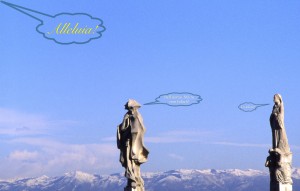L’accostamento tra la “Primavera araba” e la Riforma di Lutero rivela aspetti comuni nel modo in cui si sono diffusi i due movimenti. Entrambi hanno sfruttato le tecnologie dell’epoca: Facebook e twitter oggi, e la stampa mobile al tempo di Lutero. Ma non si tratta solo di innovazione tecnologica. Ciò che si attiva è un sistema di condivisione attraverso un network mediatico, un social-media. Lutero è abile: utilizza il sistema a stampa mobile e la forma rapida del pamphlet, provvede alle traduzioni, contatta amici e conoscenti, detto oggi: fa circolare il proprio messaggio in forma virale.
Nello scontro tra Riforma protestante e Controriforma cattolica non manca l’aspetto multimediale. Ballate facili da ricordare e xilografie che mescolano immagini a parole, vengono usate da entrambi i fronti per attaccare l’avversario (pare che i primi siano stati i riformatori e d’altra parte la Contro-riforma si è basata molto su una strategia di comunicazione per rimodellare l’immaginario cristiano).
Nell’articolo la riflessione finale è sull’importanza di vedere i social media in una prospettiva storica e si conclude: “Gli attuali sistemi di media sociali non solo ci connettono agli altri, ma ci collegano anche al passato.” Evviva!
How Luther went viral – Five centuries before Facebook and the Arab spring, social media helped bring about the Reformation (Economist.com)
Comment Luther est devenu viral, trduzione in francese (internetactu.net).
“Scholars have long debated the relative importance of printed media, oral transmission and images in rallying popular support for the Reformation. Some have championed the central role of printing, a relatively new technology at the time. Opponents of this view emphasise the importance of preaching and other forms of oral transmission. More recently historians have highlighted the role of media as a means of social signalling and co-ordinating public opinion in the Reformation.”
“Now the internet offers a new perspective on this long-running debate, namely that the important factor was not the printing press itself (which had been around since the 1450s), but the wider system of media sharing along social networks—what is called “social media” today. Luther, like the Arab revolutionaries, grasped the dynamics of this new media environment very quickly, and saw how it could spread his message.”
“In December 1517 printed editions of the theses, in the form of pamphlets and broadsheets, appeared simultaneously in Leipzig, Nuremberg and Basel, paid for by Luther’s friends to whom he had sent copies. German translations, which could be read by a wider public than Latin-speaking academics and clergy, soon followed and quickly spread throughout the German-speaking lands. Luther’s friend Friedrich Myconius later wrote that “hardly 14 days had passed when these propositions were known throughout Germany and within four weeks almost all of Christendom was familiar with them.”
“The media environment that Luther had shown himself so adept at managing had much in common with today’s online ecosystem of blogs, social networks and discussion threads. It was a decentralised system whose participants took care of distribution, deciding collectively which messages to amplify through sharing and recommendation.”
“Unlike larger books, which took weeks or months to produce, a pamphlet could be printed in a day or two. Copies of the initial edition, which cost about the same as a chicken, would first spread throughout the town where it was printed. Luther’s sympathisers recommended it to their friends. Booksellers promoted it and itinerant colporteurs hawked it. Travelling merchants, traders and preachers would then carry copies to other towns, and if they sparked sufficient interest, local printers would quickly produce their own editions, in batches of 1,000 or so, in the hope of cashing in on the buzz. A popular pamphlet would thus spread quickly without its author’s involvement.”
“Les mots ne furent pas les seuls à voyager dans les réseaux sociaux pendant l’époque de la Réforme, la musique et les images aussi. Les balades de circonstance, comme le pamphlet, étaient une forme relativement récente de médium. Elles consistaient en une description poétique, et souvent exagérée, des événements du temps, sur un ton familier qui pouvait facilement être retenu et chanté avec les autres … Both reformers and Catholics used this new form to spread information and attack their enemies.”
“Woodcuts were another form of propaganda. The combination of bold graphics with a smattering of text, printed as a broadsheet, could convey messages to the illiterate or semi-literate and serve as a visual aid for preachers. Luther remarked that “without images we can neither think nor understand anything.”
“Sous l’afflux de ces pamphlets, de ces balades et de ces gravures, l’opinion publique vira en faveur des thèses de Luther. Et ce, malgré les efforts de la censure et les tentatives des catholiques pour les noyer sous la diffusion de leurs propres thèses. Pour user d’une expression contemporaine, le message de Luther est devenu viral.”
“Modern society tends to regard itself as somehow better than previous ones, and technological advance reinforces that sense of superiority. But history teaches us that there is nothing new under the sun. Robert Darnton, an historian at Harvard University, who has studied information-sharing networks in pre-revolutionary France, argues that “the marvels of communication technology in the present have produced a false consciousness about the past—even a sense that communication has no history, or had nothing of importance to consider before the days of television and the internet.” Social media are not unprecedented: rather, they are the continuation of a long tradition. Modern digital networks may be able to do it more quickly, but even 500 years ago the sharing of media could play a supporting role in precipitating a revolution. Today’s social-media systems do not just connect us to each other: they also link us to the past.”

